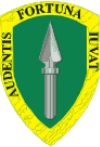Allied Rapid Reaction Corps
The Allied Rapid Reaction Corps (ARRC) is a North Atlantic Treaty Organization High Readiness Force (Land) Headquarters ready for deployment worldwide.
| Allied Rapid Reaction Corps | |
|---|---|
 | |
| Active | 2 October 1992 - Present |
| Country | and 22 other nations |
| Branch | and 22 others |
| Type | |
| Part of | |
| Garrison/HQ | Imjin Barracks, Innsworth |
| Motto(s) | Audentis fortuna iuvat Fortune favours the brave |
| Commanders | |
| Current commander | Lieutenant General Sir Edward Smyth-Osbourne, Commander (COMARRC) Major General Lorenzo D'Addario, Deputy Commander (DCOMARRC) |
History
The ARRC was created on 2 October 1992 in Bielefeld based on the former British I Corps (or I (BR) Corps).[1] It was originally created as the rapid reaction corps sized land force of the Reaction Forces Concept that emerged after the end of the Cold War, with a mission to redeploy and reinforce within Allied Command Europe (ACE) and to conduct Petersberg missions out of NATO territory. The first commander, appointed in 1992 was General Sir Jeremy Mackenzie.[2]
From 1994 the ARRC was based in the Rheindahlen Military Complex, Germany. It commanded the Land Forces of NATO's first ever deployment as part of the Implementation Force operation in Bosnia in 1995/6 and was again deployed as the headquarters commanding Land Forces during the Kosovo War in 1999.[3]
In 1997 assigned forces included the 7th Panzer Division; 2nd Greek Mechanised Division; 1st Turkish Mechanised Division (9th Armoured and 28th Mechanised Brigades, plus a third brigade, as assigned); 1st Armored Division; plus other formations, including two British divisions.[4]
Since 2002 however the HQ has been re-roled (with five other corps HQs of other NATO nations) as a High Readiness Force (Land) HQ (HRF(L)) with a broader mission. The formation HQ is under Operational Command of Supreme Allied Commander, Europe (SACEUR). The ARRC has a national Force Pool of Combat, Combat Support and Combat Service Support units with which to train and execute its mission. However, in reality COMARRC commands no forces until he receives an Activation Order from SACEUR. On receipt of ACTORD, forces from troop contributing nations, generated through the NATO Force Generation process are passed into his Operational Command for the duration of the operational deployment.[5]
ARRC took command of the International Security Assistance Force in Afghanistan on 4 May 2006 and then relocated from Rheindahlen to Imjin Barracks, outside Gloucester in England, in 2010[6] before deploying to support the ISAF Joint Command Headquarters in Afghanistan in 2011.[7]
ARRC is also regionally aligned with the European region as part of defence engagement.[8]
Structure
Currently (September 2015) the structure of HQ ARRC is as follows:[9]
- Commander (UK),
- Deputy Commander (Italy),
- Chief of Staff (UK),
- Engineers and Civil Military Integration (UK),
- Training and Security Force Assistance (UK),
- Joint Fires and Influence Branch (UK),
- Operations Division (USA),
- Personnel and Logistics (UK),
- Command Information Systems (UK),
- ARRC Enabling Command (Spain).
The deployable headquarters infrastructure and communications for HQ ARRC is provided by the 1st Signal Brigade under the Army 2020 concept.[10]
Currently the corps control the following divisions (if deployed);[11][12]
- Assigned Formations
- Other Units part of HRF(L)
- Eurocorps
- Rapid Reaction Corps
- 1st (German/Netherlands) Corps
- NATO Rapid Deployment Corps-Greece
- NATO Rapid Deployment Corps-Italy
- NATO Rapid Deployment Corps-Spain
- NATO Rapid Deployment Corps-Turkey
- Multinational Division, Southeast
Troop contributing countries
As of 1 September 2017, the ARRC is composed of service members from 23 NATO troop contributing countries:[13]
- Albania
- Belgium
- Canada
- Croatia
- Czech Republic
- Denmark
- Estonia
- France
- Germany
- Greece
- Italy
- Latvia
- Lithuania
- Norway
- Poland
- Portugal
- Romania
- Spain
- Sweden
- Netherlands
- Turkey
- United Kingdom (HQ ARRC's framework country)
- United States of America
Recent Commanders
Recent commanders have included:[14]
- 1992–1994: Lieutenant General Jeremy Mackenzie
- 1994–1997: Lieutenant General Michael Walker
- 1997–2000: Lieutenant General Mike Jackson
- 2000–2002: Lieutenant General Christopher Drewry
- 2002–2005: Lieutenant General Richard Dannatt
- 2005–2007: Lieutenant General David Richards
- 2007–2011: Lieutenant General Richard Shirreff
- 2011–2013: Lieutenant General James Bucknall
- 2013–2016: Lieutenant General Timothy Evans
- 2016–2019: Lieutenant General Tim Radford
- 2019–present: Lieutenant General Sir Edward Smyth-Osbourne[15][16]
References
- Challenges to NATO
- "Blue Hackle". Archived from the original on 26 November 2009. Retrieved 8 November 2009.
- "British general scheduled to lead NATO's Kosovo peacekeeping force". The Baltimore Sun. 5 June 1999. Retrieved 14 July 2013.
- 'ARRC Assigned Forces', "NATO's Sixteen Nations," Special Issue 1998, p.6.
- "Other High Readiness Forces (Land)". NATO. Retrieved 23 June 2018.
- UK Parliament Statement, URL retrieved 17 May 2008
- UK MOD website
- "Information regarding British Army brigades being regionally aligned" (PDF). assets.publishing.service.gov.uk. Ministry of Defence UK. 2 August 2019. Retrieved 9 April 2020.
Responsible Organisation HQ Allied Rapid Reaction Corps Region Europe
- About ARRC: Structure Archived 14 June 2012 at the Wayback Machine
- Army 2020 Report
- "ARRC | Assigned Formations". arrc.nato.int. Retrieved 17 October 2019.
- "ARRC | Other High Readiness Forces (Land)". arrc.nato.int. Retrieved 17 October 2019.
- "Today we officially welcome Romania and... - Headquarters Allied Rapid Reaction Corps (HQ ARRC)". Facebook.com. 1 September 2017. Retrieved 11 October 2017.
- Army Commands Archived 5 July 2015 at the Wayback Machine
- @HQARRC (18 July 2019). "Lieutenant General Tim Radford (left) at the handover of command to Lieutenant General Sir Edward Smyth-Osbourne" (Tweet) – via Twitter.
- "Top Brass Picks Up". The Imjin. p. 4. Retrieved 19 July 2019.